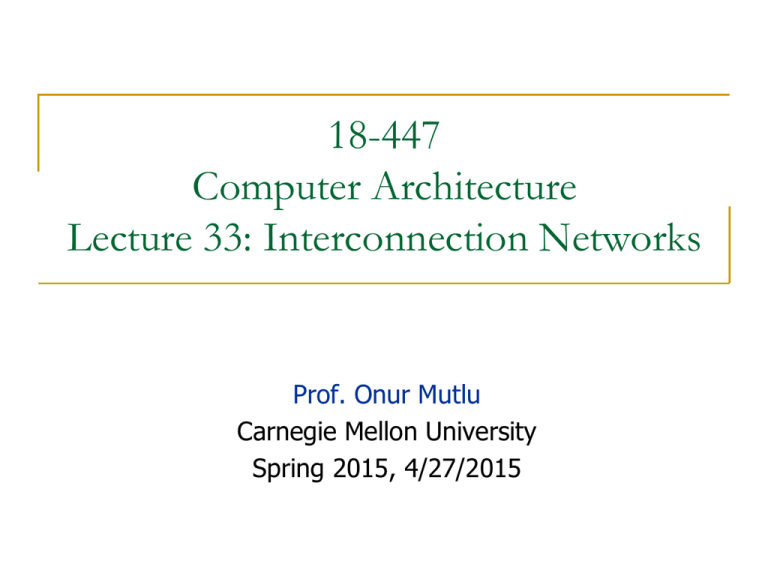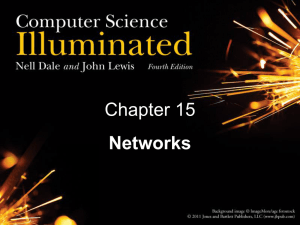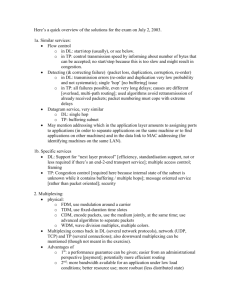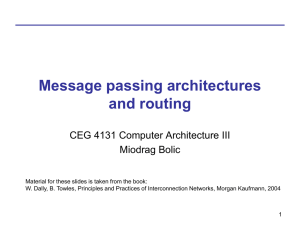18-447 Computer Architecture Lecture 33: Interconnection Networks Prof. Onur Mutlu
advertisement

18-447 Computer Architecture Lecture 33: Interconnection Networks Prof. Onur Mutlu Carnegie Mellon University Spring 2015, 4/27/2015 Logistics Lab 7 and Lab 8 Final Exam Midterm II scores Course grades so far Course evaluations 740 next semester Plans for Wed and Fri lectures 2 Lab 6 Extra Credit 2.5% 2.5% 2.5% 2.0% 2.0% 2.0% 2.0% 1.5% Ashish Shrestha (ashresth) Amanda Marano (amarano) Pete Ehrett (wpe) Jared Choi (jaewonch) Akshai Subramanian (avsubram) Sohil Shah (sohils) Raghav Gupta (raghavg) Kais Kudrolli (kkudroll) 3 Lab 7 Abstract, cycle-level modeling of the memory hierarchy You can submit until May 1 and still get full credit Feel free to submit the Extra Credit portion as well L2 Cache and Main Memory Controllers A key part of all modern computing systems today Prefetching You can get up to 2% of course grade as extra credit Remember: The goal is for you to learn… 4 Extra Credit Lab 8: Multi-Core Cache Coherence Completely extra credit (all get 5% for free; can get 5% more) Last submission accepted on May 10, 11:59pm; no late submissions Cycle-level modeling of the MESI cache coherence protocol 5 Midterm 2 Grade Distribution Midterm 2 Scores 7 AVG = 152 Median = 154 STDDEV = 37 Max = 240 Min = 61 # of Students 6 5 4 3 2 1 0 0 20 40 60 80 100 120 140 160 180 200 220 240 260 280 300 320 Bins (points) 6 Midterm 2 Grade Distribution (%) Midterm 2 Scores (%) 10 AVG = 45 Median = 45 STDDEV = 40 Max = 71 Min = 18 # of Students 9 8 7 6 5 4 3 2 1 0 0 10 20 30 40 50 60 Bins (%) 70 80 90 100 7 Final Exam: May 5 May 5, 5:30-8:30pm, Location: BH A51 Comprehensive (over all topics in course) Three cheat sheets allowed We will (likely) have a review session on Friday Remember this is 22% of your grade I will take into account your improvement over the course Know all concepts, especially the previous midterm concepts Same advice as before for Midterms I and II 8 Course Grades So Far Number of Students 6 5 AVG = 57 Median = 58 STDDEV = 6.5 Max = 66 Min = 43 Max_possible = 71 Max_possible + EC = 87.15 4 3 2 1 0 0 4 8 12 16 20 24 28 32 36 40 44 48 52 56 60 64 68 72 Bins (percentage) 9 A Note on 740, Research, Jobs/Internships I am teaching 740 next semester (Fall 2015) Lectures M, W 7:30-9:20pm Recitations T 7:30-9:20pm If you are enjoying 447 and are doing well, you can take it feel free to talk with me If you are excited about Computer Architecture research or looking for a job/internship in this area talk with me 10 More on 740 740 is the next course in sequence Time: Lect. MW 7:30-9:20pm, Rect. T 7:30-9:20pm Content: Lectures: More advanced, with a different perspective Recitations: Delving deeper into papers, advanced topics Readings: Many fundamental and research readings; will do many reviews Project: More open ended research project. Proposal milestones final poster and presentation Done in groups of 1-3 Focus of the course is the project and critical reviews of readings Exams: lighter and fewer Homeworks: None 11 Course Evaluations (due May 11) Due May 11, 11:59pm Please do not forget to fill out the course evaluations Your feedback is very important I read these very carefully, and take into account every piece of feedback http://www.cmu.edu/hub/fce/ And, improve the course for the future Please take the time to write out feedback State the things you liked, topics you enjoyed, what you think the course contributed to your learning, what we can improve on Please don’t just say “the course is hard and fast paced” Because you knew that from the very beginning! 12 Extra Credit for Course Evaluations 0.25% extra credit for everyone in the class if more than 90% (i.e., 25) of you fill out the evaluations 13 Plan for Wed and Fri Sessions This Week Wednesday: Informal Q&A Session Location: Porch Tentative format: Fun, information, food Come with questions (about comp arch/systems, and anything else) We will have food Friday: Final Exam Review Location: HH 1107 Tentative format: TAs will go over Midterms I and II and answer your questions 14 Where We Are in Lecture Schedule The memory hierarchy Caches, caches, more caches Virtualizing the memory hierarchy: Virtual Memory Main memory: DRAM Main memory control, scheduling Memory latency tolerance techniques Non-volatile memory Multiprocessors Coherence and consistency In-memory computation and predictable performance Multi-core issues (e.g., heterogeneous multi-core) Interconnection networks 15 Interconnection Network Basics 16 Where Is Interconnect Used? To connect components Many examples Processors and processors Processors and memories (banks) Processors and caches (banks) Caches and caches I/O devices Interconnection network 17 Why Is It Important? Affects the scalability of the system How large of a system can you build? How easily can you add more processors? Affects performance and energy efficiency How fast can processors, caches, and memory communicate? How long are the latencies to memory? How much energy is spent on communication? 18 Interconnection Network Basics Topology Routing (algorithm) Specifies the way switches are wired Affects routing, reliability, throughput, latency, building ease How does a message get from source to destination Static or adaptive Buffering and Flow Control What do we store within the network? Entire packets, parts of packets, etc? How do we throttle during oversubscription? Tightly coupled with routing strategy 19 Topology Bus (simplest) Point-to-point connections (ideal and most costly) Crossbar (less costly) Ring Tree Omega Hypercube Mesh Torus Butterfly … 20 Metrics to Evaluate Interconnect Topology Cost Latency (in hops, in nanoseconds) Contention Many others exist you should think about Energy Bandwidth Overall system performance 21 Bus All nodes connected to a single link + Simple + Cost effective for a small number of nodes + Easy to implement coherence (snooping and serialization) - Not scalable to large number of nodes (limited bandwidth, electrical loading reduced frequency) - High contention fast saturation 0 1 2 Memory 3 Memory 4 Memory 5 6 7 Memory cache cache cache cache Proc Proc Proc Proc 22 Point-to-Point Every node connected to every other with direct/isolated links 0 7 1 + Lowest contention + Potentially lowest latency + Ideal, if cost is no issue 6 -- Highest cost O(N) connections/ports per node O(N2) links -- Not scalable -- How to lay out on chip? 2 5 3 4 23 Crossbar Every node connected to every other with a shared link for each destination Enables concurrent transfers to non-conflicting destinations Could be cost-effective for small number of nodes 7 + Low latency and high throughput - Expensive - Not scalable O(N2) cost - Difficult to arbitrate as N increases 6 5 4 3 2 Used in core-to-cache-bank networks in - IBM POWER5 - Sun Niagara I/II 1 0 0 1 2 3 4 5 6 7 24 Another Crossbar Design 0 1 2 3 4 5 6 7 0 1 2 3 4 5 6 7 25 Sun UltraSPARC T2 Core-to-Cache Crossbar High bandwidth interface between 8 cores and 8 L2 banks & NCU 4-stage pipeline: req, arbitration, selection, transmission 2-deep queue for each src/dest pair to hold data transfer request 26 Bufferless and Buffered Crossbars 0 NI 1 NI 2 NI 3 NI + Simpler arbitration/ scheduling Flow Control Flow Control + Efficient support for variable-size packets Flow Control Flow Control Bufferless Buffered Crossbar Output Arbiter Output Arbiter Output Arbiter Output Arbiter - Requires N2 buffers 27 Can We Get Lower Cost than A Crossbar? Yet still have low contention compared to a bus? Idea: Multistage networks 28 Multistage Logarithmic Networks Idea: Indirect networks with multiple layers of switches between terminals/nodes Cost: O(NlogN), Latency: O(logN) Many variations (Omega, Butterfly, Benes, Banyan, …) Omega Network: Omega Net w or k 000 000 001 001 010 011 010 011 100 100 101 101 110 111 110 111 conflict 29 Multistage Networks (Circuit Switched) 0 0 1 1 2 2 3 3 4 4 5 5 6 6 7 A multistage network has more restrictions on feasible concurrent Tx-Rx pairs vs a crossbar But more scalable than crossbar in cost, e.g., O(N logN) for Butterfly 7 2-by-2 crossbar 30 Multistage Networks (Packet Switched) 0 0 1 1 2 2 3 3 4 4 5 5 6 6 7 7 2-by-2 router Packets “hop” from router to router, pending availability of the next-required switch and buffer 31 Aside: Circuit vs. Packet Switching Circuit switching sets up full path before transmission Establish route then send data Noone else can use those links while “circuit” is set + faster arbitration -- setting up and bringing down “path” takes time Packet switching routes per packet in each router Route each packet individually (possibly via different paths) If link is free, any packet can use it -- potentially slower --- must dynamically switch + no setup, bring down time + more flexible, does not underutilize links 32 Switching vs. Topology Circuit/packet switching choice independent of topology It is a higher-level protocol on how a message gets sent to a destination However, some topologies are more amenable to circuit vs. packet switching 33 Another Example: Delta Network Single path from source to destination Each stage has different routers Proposed to replace costly crossbars as processor-memory interconnect Janak H. Patel ,“ProcessorMemory Interconnections for Multiprocessors,” ISCA 1979. 8x8 Delta network 34 Another Example: Omega Network Single path from source to destination All stages are the same Used in NYU Ultracomputer Gottlieb et al. “The NYU Ultracomputer - Designing an MIMD Shared Memory Parallel Computer,” IEEE Trans. On Comp., 1983. 35 Ring Each node connected to exactly two other nodes. Nodes form a continuous pathway such that packets can reach any node. + Cheap: O(N) cost - High latency: O(N) - Not easy to scale - Bisection bandwidth remains constant Used in Intel Haswell, Intel Larrabee, IBM Cell, many commercial systems today RING S S S P P P M M M 36 Unidirectional Ring R R R R N-2 N-1 2x2 router 0 1 2 Single directional pathway Simple topology and implementation Reasonable performance if N and performance needs (bandwidth & latency) still moderately low O(N) cost N/2 average hops; latency depends on utilization 37 Bidirectional Rings Multi-directional pathways, or multiple rings + Reduces latency + Improves scalability - Slightly more complex injection policy (need to select which ring to inject a packet into) 38 Hierarchical Rings + More scalable + Lower latency - More complex 39 More on Hierarchical Rings Rachata+, “Design and Evaluation of Hierarchical Rings with Deflection Routing,” SBAC-PAD 2014. http://users.ece.cmu.edu/~omutlu/pub/hierarchical-ringswith-deflection_sbacpad14.pdf Discusses the design and implementation of a mostlybufferless hierarchical ring 40 Mesh Each node connected to 4 neighbors (N, E, S, W) O(N) cost Average latency: O(sqrt(N)) Easy to layout on-chip: regular and equal-length links Path diversity: many ways to get from one node to another Used in Tilera 100-core And many on-chip network prototypes 41 Torus Mesh is not symmetric on edges: performance very sensitive to placement of task on edge vs. middle Torus avoids this problem + Higher path diversity (and bisection bandwidth) than mesh - Higher cost - Harder to lay out on-chip - Unequal link lengths 42 Torus, continued Weave nodes to make inter-node latencies ~constant S S MP S MP S MP S MP S MP S MP S MP MP 43 Trees Planar, hierarchical topology Latency: O(logN) Good for local traffic + Cheap: O(N) cost + Easy to Layout - Root can become a bottleneck Fat trees avoid this problem (CM-5) Fat Tree 44 CM-5 Fat Tree Fat tree based on 4x2 switches Randomized routing on the way up Combining, multicast, reduction operators supported in hardware Thinking Machines Corp., “The Connection Machine CM-5 Technical Summary,” Jan. 1992. 45 Hypercube “N-dimensional cube” or “N-cube” Latency: O(logN) Radix: O(logN) #links: O(NlogN) + Low latency - Hard to lay out in 2D/3D 11 01 11 01 00 01 01 11 10 11 01 00 10 01 01 10 10 00 00 11 00 01 00 00 11 11 10 11 10 10 00 10 46 Caltech Cosmic Cube 64-node message passing machine Seitz, “The Cosmic Cube,” CACM 1985. 47 Interconnection Network Basics Topology Routing (algorithm) Specifies the way switches are wired Affects routing, reliability, throughput, latency, building ease How does a message get from source to destination Static or adaptive Buffering and Flow Control What do we store within the network? Entire packets, parts of packets, etc? How do we throttle during oversubscription? Tightly coupled with routing strategy 48 Handling Contention Two packets trying to use the same link at the same time What do you do? Buffer one Drop one Misroute one (deflection) Tradeoffs? 49 Bufferless Deflection Routing Key idea: Packets are never buffered in the network. When two packets contend for the same link, one is deflected.1 New traffic can be injected whenever there is a free output link. Destination 1Baran, “On Distributed Communication Networks.” RAND Tech. Report., 1962 / IEEE Trans.Comm., 1964.50 Bufferless Deflection Routing Input buffers are eliminated: packets are buffered in pipeline latches and on network links Input Buffers North North South South East East West West Local Local Deflection Routing Logic 51 Routing Algorithm Three Types Deterministic: always chooses the same path for a communicating source-destination pair Oblivious: chooses different paths, without considering network state Adaptive: can choose different paths, adapting to the state of the network How to adapt Local/global feedback Minimal or non-minimal paths 52 Deterministic Routing All packets between the same (source, dest) pair take the same path Dimension-order routing First traverse dimension X, then traverse dimension Y E.g., XY routing (used in Cray T3D, and many on-chip networks) + Simple + Deadlock freedom (no cycles in resource allocation) - Could lead to high contention - Does not exploit path diversity 53 Deadlock No forward progress Caused by circular dependencies on resources Each packet waits for a buffer occupied by another packet downstream 54 Handling Deadlock Avoid cycles in routing Dimension order routing Cannot build a circular dependency Restrict the “turns” each packet can take Avoid deadlock by adding more buffering (escape paths) Detect and break deadlock Preemption of buffers 55 Turn Model to Avoid Deadlock Idea Analyze directions in which packets can turn in the network Determine the cycles that such turns can form Prohibit just enough turns to break possible cycles Glass and Ni, “The Turn Model for Adaptive Routing,” ISCA 1992. 56 Oblivious Routing: Valiant’s Algorithm An example of oblivious algorithm Goal: Balance network load Idea: Randomly choose an intermediate destination, route to it first, then route from there to destination Between source-intermediate and intermediate-dest, can use dimension order routing + Randomizes/balances network load - Non minimal (packet latency can increase) Optimizations: Do this on high load Restrict the intermediate node to be close (in the same quadrant) 57 Adaptive Routing Minimal adaptive Router uses network state (e.g., downstream buffer occupancy) to pick which “productive” output port to send a packet to Productive output port: port that gets the packet closer to its destination + Aware of local congestion - Minimality restricts achievable link utilization (load balance) Non-minimal (fully) adaptive “Misroute” packets to non-productive output ports based on network state + Can achieve better network utilization and load balance - Need to guarantee livelock freedom 58 On-Chip Networks PE PE R PE PE PE PE R PE R PE R R PE R R • Connect cores, caches, memory controllers, etc R PE R R – Buses and crossbars are not scalable • Packet switched • 2D mesh: Most commonly used topology • Primarily serve cache misses and memory requests Router Processing Element (Cores, L2 Banks, Memory Controllers, etc) 59








